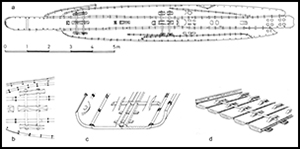Article contents
Plankboat skeuomorphs in Bronze Age logboats: a Scandinavian perspective
Published online by Cambridge University Press: 07 December 2015
Abstract

Logboats are widely known as the earliest form of water transport and continue to be used today. How then can such a ubiquitous phenomenon be useful in demonstrating maritime networks between distant places? A reassessment of the European, and especially Scandinavian, examples of logboats has revealed that technological and decorative aspects of their design demonstrate a connection between Western Europe, Scandinavia and Britain and Ireland. Here the details of this skeuomorphism are used to argue for a North Atlantic, European maritime network in the Bronze Age.
- Type
- Research
- Information
- Copyright
- Copyright © Antiquity Publications Ltd, 2015
References
- 6
- Cited by


